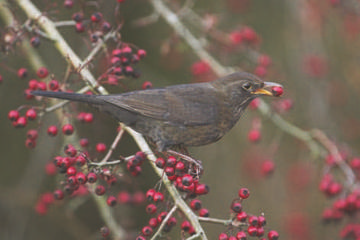
Blackbird © Simon Booth
Blackbirds were reported from 655 tetrads in winter, everywhere in the county apart from the estuarine saltmarshes. Many of the birds seen will have been the same individuals as in the breeding season, for most British Blackbirds are sedentary, and have become even less likely to move in the last quarter-century (Migration Atlas). The tendency of some individuals to leave the country has ceased since Coward (1910) wrote ‘in the autumn many of the birds leave us’ and Bell (1962, 1967) detailed several examples of ringed birds. Both members of a pair defend a joint territory in winter, although they might split it and argue over the boundary (Brown & Grice 2005).
Winter numbers are augmented by an influx of birds from Fennoscandia, the Baltic States and elsewhere in northern Europe. The northerly birds tend to be larger, and some can be distinguished in the hand; they are more likely to be found in more remote sites, away from people, although some in gardens are foreign birds, as ringers know. Apart from SK07A, birds were found in all of the tetrads in the eastern hill country, in small numbers, with the largest reported flock being ten birds that Steve and Gill Barber saw, about 450 m above sea level, feeding among a herd of goats at Whitehills (SJ97R).
In winter Blackbirds still like to eat invertebrates whenever they can find them, above all earthworms. On a still, frosty day, Blackbirds in woodland can often be heard from some distance as they noisily scratch through the leaf litter on the woodland floor. But their winter diet contains much more fruit, especially haws, usually taken early in winter, ivy and rowan, with apples as a standby.
The habitats recorded were much the same as in the breeding season – human sites, woodland and farmland, with some in scrub – and the main change is a proportionate reduction in all categories and a huge increase in birds in hedges, with this habitat being recorded in half of all tetrads. More than 40% of the hedge records were in the low (shorter than 2 m) class, and this species may tolerate hedge-trimming better than most, provided that the fruits remain.
Many Blackbirds roost communally, even some of the territorial birds leaving their domain for the night, usually in dense vegetation providing good shelter from winds. Rhododendron scrub under mature trees makes an ideal site, and other suitable roost locations include hedges, conifer plantations, brambles, gorse, and evergreen creepers on buildings (Simms 1978). Surprisingly, as few as eight roosts were reported during this Atlas, with the only substantial count being around 100 at Norton Priory, Runcorn (SJ58L). Other than at roosts, Blackbirds are not often found in large flocks and half of all the submitted counts were of four birds or fewer.
Blackbirds seldom undertake hard-weather movements and are likely to try to tough it out in even the worst of winter conditions (BTO Winter Atlas), probably because of the dedication of most resident birds to a territory. By the time our defined winter period finishes at the end of February, many of the immigrants are preparing to depart – birds ringed in winter in the county have been reported near Stockholm, Sweden as early as 11 March, and in Germany on 15 March – and many of the local birds are starting to breed.
Sponsored by Mrs Edna Draper

